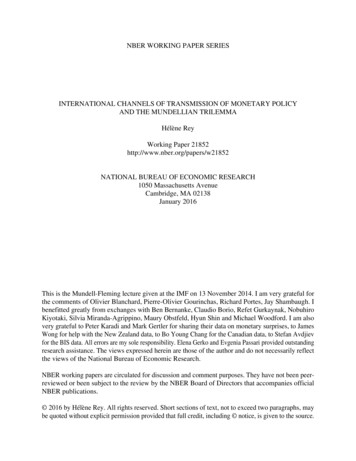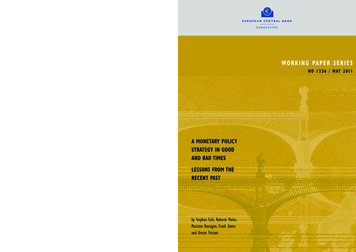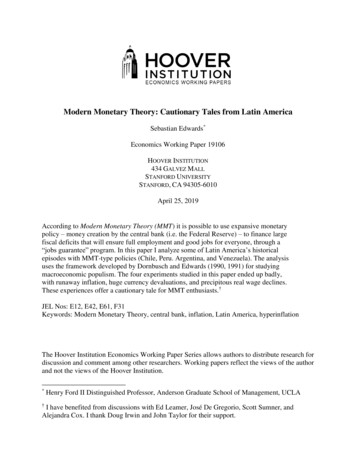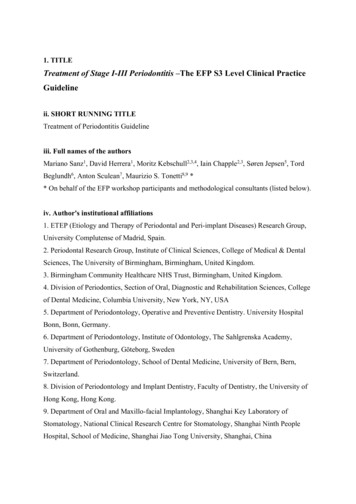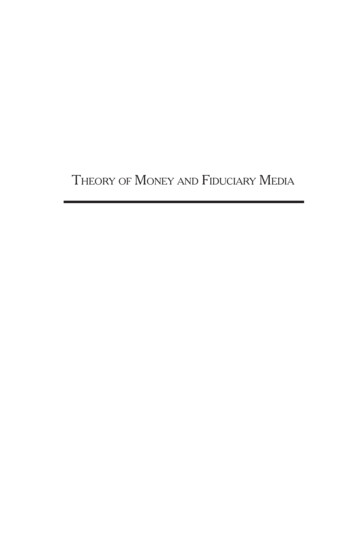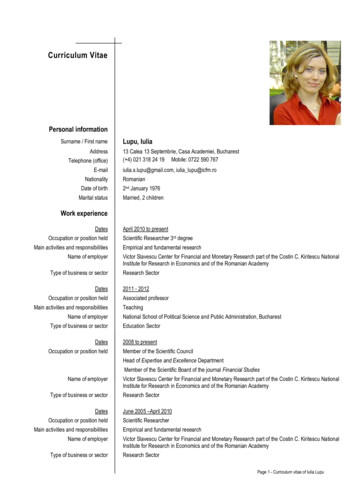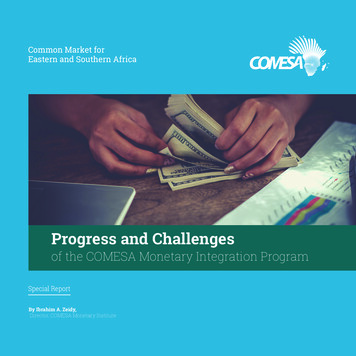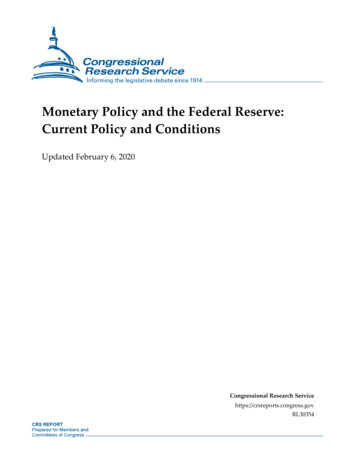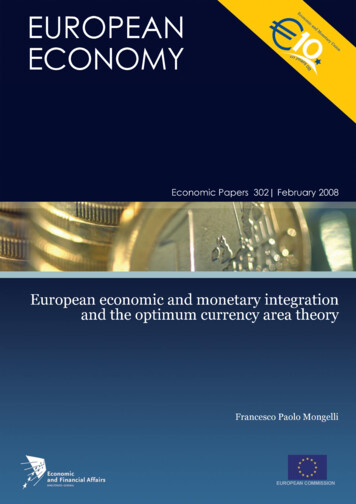
Transcription
EUROPEANECONOMYEconomicPapers302 andtheoptimum MMISSION
EMU@10 ResearchIn May 2008, it will be ten years since the final decision to move to the third and final stage ofEconomic and Monetary Union (EMU), and the decision on which countries would be the first tointroduce the euro. To mark this anniversary, the Commission is undertaking a strategic review ofEMU. This paper constitutes part of the research that was either conducted or financed by theCommission as source material for the review.Economic Papers are written by the Staff of the Directorate-General for Economic and FinancialAffairs, or by experts working in association with them. The Papers are intended to increase awarenessof the technical work being done by staff and to seek comments and suggestions for further analysis.The views expressed are the author’s alone and do not necessarily correspond to those of the EuropeanCommission. Comments and enquiries should be addressed to:European CommissionDirectorate-General for Economic and Financial AffairsPublicationsB-1049 BrusselsBelgiumE-mail: Ecfin-Info@ec.europa.euThis paper exists in English only and can be downloaded from the websitehttp://ec.europa.eu/economy finance/publicationsA great deal of additional information is available on the Internet. It can be accessed through theEuropa server (http://europa.eu)ISBN 978-92-79-08227-6doi: 10.2765/3306 European Communities, 2008
European Economic and Monetary Integration, andthe Optimum Currency Area TheoryFrancesco Paolo Mongelli (ECB) Abstract:This essay follows the synergies and complementarities between European Economic andMonetary Union (EMU) and the optimum currency area (OCA) theory. Variousadvancements in economic theory and econometrics have made it possible to progress fromthe “early OCA theory” to a “new OCA theory”. The balance of judgements has shifted infavour of monetary union: it is deemed to generate fewer costs and there is more emphasis onbenefits. The “endogeneity of OCA” has further strengthened this consideration. Yet there isstill no simple OCA test. When EMU made the leap to the Maastricht Treaty, the OCA theorycould not deliver clear policy guidance. Plans for EMU went ahead as a follow-up of theSingle Market Programme (SMP) with only limited direct input from the OCA theory. Themain concern was to remove the risks of destabilising exchange rate volatilities andmisalignments that had disrupted the European Monetary System (EMS) on severaloccasions. While plans for EMU were advancing, it became apparent that several (future)euro area countries were still faring poorly under some OCA properties and concerns about“Eurosclerosis” emerged. The implications for EMU were cautionary. Over the last 10 to 15years initiatives promoting structural reforms have been at the centre of policy-making (e.g.the Lisbon Agenda). Hence, under the surface the OCA theory was being heeded, andEuropean countries were tackling their structural weaknesses. We can almost talk of an OCAtheory in reverse. If we look at the broad governance structure of EMU there may be an“exogeneity of OCA”. So here we are: with the benefit of eight years of hindsight, what canwe say about the functioning of EMU thus far? Can we also say something more about itsvarious benefits and costs?JEL classification: E42, F15, F33 and F41.Keyword: Optimum currency area, economic and monetary integration, internationalmonetary arrangements, EMU This essay is dedicated to W. Max Corden, who posed many of the difficult questions on monetaryintegration. I would like to thank Manfred Kremer, Hedwig Ongena, Ivo Maes, João Nogueira Martins,Chiara Osbat, Lina Bukeviciute, Malin Andersson, Luca Onorante, Tobias Blattner and MaurizioHabib for their various contributions and Juliette Cuvry for her assistance. An earlier draft of this paperwas presented at the DG ECFIN and BEPA workshop on “EMU@10: Achievements andChallenges” that was held in Brussels on 26-27 November 2007. I take full responsibility for anyerrors and omissions. The views expressed are mine and do not necessarily reflect those of the ECB.
“EMU will have a very pervasive impact on the working of the economy. Many differentmechanisms will come into play and interact.” “One Market, One Money” (1990)1. IntroductionThe call for this conference noted that the “fixing of the irrevocable conversion rates tothe euro for the currencies of eleven EU countries on 31 December 1998 created laboratoryconditions for examining the importance of various concerns about monetary unification, oneof which being whether the countries joining in the euro did form an optimum currency area(OCA)”. Furthermore, “early work suggested that the European countries might not havescored very highly on all OCA criteria. Yet, the successful establishment of economic andmonetary union (EMU) suggests that the conventional OCA theory may not account fully forthe net benefits deriving from currency unions”. A lot runs through these lines.The analogy of EMU with a laboratory is tempting, and we show that we are dealing witha very busy laboratory. In fact, over the last 50 years diverse forces and processes have beenat work. First, European monetary integration has been part of the broader process ofeconomic and financial integration. Second, European integration is a political process. Theimportance of the political origins, motivations and consequences of European integrationcannot be overemphasised. Third, economic, financial and monetary integration has evolvedgradually over a long period, and is still evolving. All along, national economies have neededto adjust to the changing market structures but also institutional setting. Fourth, theadvancement of European integration has proceeded hand in hand with the advancements ofeconomic theory: the synergies and complementarities with the OCA theory are an example.The essay is organised as follows. Section 2 revisits the OCA theory and the various OCAproperties that would support the launch of a single currency and ensure that the benefits frommonetary integration exceed the costs. Section 3 reviews the path to European monetaryintegration. Despite the similarity in terms of goal, the issue of establishing EMU is differentfrom the OCA issue. The EMU issue has more dimensions and facets. In Section 4 we look atvarious aspects of the functioning of EMU, including: the working of the real interestchannel, the risk of pro-cyclicality of fiscal policies, the changes in competitiveness withinthe euro area, the relationship between EMU and the drive towards structural reforms, thecentral role played by financial integration for the functioning of monetary unions and theimpact of the euro on specialisation. Section 5 provides some insight into the main benefitsand costs of the euro. Section 6 makes some final remarks.“The OCA theory is back. Once dismissed as a "dead-end problem" with little practicalsignificance the issue has been resuscitated and re-thought” George Tavlas (1993)2. The evolving optimum currency area theoryAlmost 50 years have passed since the founding of the optimum currency area (OCA)theory thanks to the seminal contributions of, among others, Mundell (1961), McKinnon(1963) and Kenen (1969). Several other important contributions followed suit highlighting awide range of OCA properties that are desirable features for economies wanting to share asingle currency. All of these properties are still central in the debate on monetary integration.This section presents the main elements of the OCA theory, lays out its main weaknesses andlimitations, and outlines some “meta” OCA properties and the “endogeneity of OCA”.1
The main elements of the OCA theoryAn optimum currency area (OCA) can be defined as the optimal geographical area for asingle currency, or for several currencies, whose exchange rates are irrevocably pegged. Thesingle currency, or the pegged currencies, fluctuate jointly vis-à-vis other currencies. Theborders of an OCA are defined by the sovereign countries choosing to participate in thecurrency area. Optimality is defined in terms of various OCA properties, such as price andwage flexibility, financial integration, etc., as listed in Box 2.1 below. Some other “meta”properties, looking at the similarity of shocks and monetary transmission mechanisms,surfaced later. Sharing these OCA properties reduces the usefulness of nominal exchange rateadjustments within the currency area by lessening the impact of some types of shocks orfacilitating their adjustment thereafter. Countries forming a currency area expect benefits toexceed costs (see Section 5).Box 2.1. The OCA properties (I): the seminal contributionsThe literature on the OCA theory came to light in the early 1960s: a period characterised inter aliaby the Bretton Woods fixed (but adjustable) exchange rate regime, capital controls in manycountries and the incipient process of European integration. Various OCA properties – also called“prerequisites,” “characteristics,” “ criterion” or “criteria” by some authors – emerged from thedebate on the merits of fixed versus flexible exchange rate regimes, and also the comparison ofseveral features of the US and European economies. They constitute the “early OCA theory”.a. Price and wage flexibility. When nominal prices and wages are flexible between and withincountries contemplating a single currency, the transition towards adjustment following a shock isless likely to be associated with sustained unemployment in one country and/or inflation inanother. This will in turn diminish the need for nominal exchange rate adjustments (Friedman(1953)). Alternatively, if nominal prices and wages are downward rigid some measure of realflexibility could be achieved by means of exchange rate adjustments. In this case the loss of directcontrol over the nominal exchange rate instrument represents a cost (Kawai (1987)).b. Mobility of factors of production including labour. High factor market integration within agroup of partner countries can reduce the need to alter real factor prices and the nominal exchangerate between countries in response to disturbances (Mundell (1961)). Trade theory has longestablished that the mobility of factors of production enhances both efficiency and welfare. Suchmobility is likely to be modest in the very short run and could display its effect over time. Themobility of factors of production is limited by the pace at which direct investment can begenerated by one country and absorbed by another. Similarly, labour mobility is likely to be low inthe short run, due to significant costs, such as for migration and retraining. Mobility, however, mayincrease in the medium and long run, easing the adjustment to permanent shocks.c. Financial market integration. Ingram (1962) noted that financial integration can reduce theneed for exchange rate adjustments. It may cushion temporary adverse disturbances through capitalinflows – e.g. by borrowing from surplus areas or decumulating net foreign assets that can bereverted when the shock is over. With a high degree of financial integration even modest changesin interest rates would elicit equilibrating capital movements across partner countries. This wouldreduce differences in long-term interest rates, easing the financing of external imbalances but alsofostering an efficient allocation of resources. Financial integration is not a substitute for apermanent adjustment when necessary: in this case, it can only smooth this process. Temporaryfinancial flows may induce a postponement of real adjustment and render it more difficult at alater stage. Some authors also warn that financial integration might lead to destabilising capitalmovements.2
McKinnon (2004) analyses in depth the implications of a second seminal contribution byMundell (1973) discussing the role of financial integration, in the form of cross-country assetholding, for international risk-sharing. Countries sharing a single currency can mitigate the effectsof asymmetric shocks by diversifying their income sources,. This can operate through incomeinsurance when a country’s residents hold claims to dividends, interests and rental revenue fromother countries. Such ex ante insurance allows the smoothing of both temporary and permanentshocks as long as output is imperfectly correlated. Country’s residents can also adjust their wealthportfolio – e.g. in response to income fluctuations -- by buying and selling assets and borrowingand lending on international credit markets: an ex post adjustment.A corollary of this argument is that similarity of shocks is not a strict prerequisite forsharing a single currency if all members of the currency area are financially integrated and holdclaims on each other’s output. In many ways some speak of a Mundell I versus a Mundell IIpositive and normative approach to EMU. The latter point has important implications for thedebate on monetary integration: a new currency could be shared by countries subject toasymmetric shocks as long as they “insure” one another through private financial markets. Thisexplains the emphasis on the need to strengthen financial integration in the subsequent literature.d. The degree of economic openness. The higher the degree of openness, the more changes ininternational prices of tradables are likely to be transmitted to the domestic cost of living. Thiswould in turn reduce the potential for money and/or exchange rate illusion by wage earners(McKinnon (1963). Also, a devaluation would be more rapidly transmitted to the price oftradables and the cost of living, negating its intended effects. Hence the nominal exchange ratewould be less useful as an adjustment instrument. Economic openness needs to be assessed alongseveral dimensions, including the overall openness of a country to trade with the world; the degreeof openness vis-à-vis the countries with which it intends to share a single currency; the share oftradable versus non-tradable goods and services in production and consumption; and the marginalpropensity to import. These dimensions of openness overlap but are not synonymous. Later workshowed that monetary integration catalyses further openness: i.e., the “endogeneity of OCA”.e. The diversification in production and consumption. High diversification in productionand consumption, such as the “portfolio of jobs”, and correspondingly in imports and exports,dilutes the possible impact of shocks specific to any particular sector. Therefore, diversificationreduces the need for changes in the terms of trade via the nominal exchange rate and provides“insulation” against a variety of disturbances (Kenen (1969). Highly diversified partner countriesare more likely to incur reduced costs as a result of forsaking nominal exchange rate changesbetween them and find a single currency beneficial.f. Similarities of inflation rates. External imbalances can arise also from persistent differencesin national inflation rates resulting from differences in: structural developments, labour market,economic policies, and social preferences (such as inflation aversion). Fleming (1971) notes thatwhen inflation rates between countries are low and similar over time, terms of trade will alsoremain fairly stable. This will foster more equilibrated current account transactions and trade,reducing the need for nominal exchange rate adjustments.g. Fiscal integration. Countries sharing a supranational fiscal transfer system to redistributefunds to a member country affected by an adverse asymmetric shock would also be facilitated inthe adjustment to such shocks and might require less nominal exchange rate adjustments (Kenen(1969). However, this would require an advanced degree of political integration and willingness toundertake such risk-sharing.h. Political integration. The political will to integrate is regarded by some as among the mostimportant condition for sharing a single currency (Mintz (1970). Political will fosters compliancewith joint commitments, sustains cooperation on various economic policies, and encourages moreinstitutional linkages. Haberler (1970) stresses that a similarity of policy attitudes among partnercountries is relevant in turning a group of countries into a successful currency area. Tower andWillett (1976) add that for a successful OCA, policy-makers need to trade-off between objectives.3
Weaknesses and limitations of the OCA theoryAfter the “early OCA theory” was completely mapped out, several weaknesses andlimitations started emerging. Others emerged over time and are decades apart. We list themhere for presentational convenience.a. Robson (1987) notes how several OCA properties are difficult to measure unambiguously.b. OCA properties are also difficult to evaluate against each other: i.e. the OCA theory as awhole lacked a unifying framework. One could still end up drawing different borders for acurrency area by referring to different OCA properties. Tavlas (1994) calls this the “problemof inconclusiveness”, as OCA properties may point in different directions: for example, acountry might be quite open in terms of reciprocal trade with a group of partner countriesindicating that a fixed exchange rate regime is preferable, or even monetary integration, withits main trading partners. However, the same country might display a low mobility of factorsof production, including labour, vis-à-vis these trading partners, suggesting instead that aflexible exchange rate arrangement might be desirable.c. Tavlas (1994) also observes that there can be a “problem of inconsistency”. For example,small economies, which are generally more open, should preferably adopt a fixed exchangerate, or even integrate monetarily, with their main partners following the openness property.However, the same small economies are more likely to be less differentiated in productionthan larger ones. In this case they would be better candidates for flexible exchange ratesaccording to the diversification in production property. Conversely, McKinnon (1969) notesthat more differentiated economies are generally larger and have smaller trade sectors.d. After the seminal contributions on the diverse OCA properties, the analytical frameworkbehind the OCA theory started weakening (see next sub-section): all its main tenets werecalled into question by new theoretical and empirical advancements. Tavlas (1993) notes thatfrom the mid-1970s until the mid-1980s “the subject [OCA theory] was for years consignedto intellectual limbo”. Economists and policy-makers looking at the OCA theory could notfind clear answers to the question as to whether Europe should proceed towards completemonetary integration, and which countries would be fit to join.e. The “One Market, One Money” report by Emerson et al. (1992) points out that “there isno ready-to-use theory for assessing the costs and benefits of economic and monetary union”.The OCA theory has, in their view, provided important early insights but offers only a narrowand outdated analytical framework to define the optimum economic and monetarycompetencies of a given “area” such as the EU: i.e., it is unable to tell which countries shouldshare a single currency. The latter EMU question is more complex than the OCA question.f. Studies investigating OCA properties are by necessity backward-looking. They cannotreflect a change in policy preferences, or a switch in policy regime such as monetaryunification. Instead, in the second half of the 1990s, several authors started raising the issue ofthe endogenous effects of monetary integration: i.e., whether sharing a single currency mayset in motion forces bringing countries closer together. This is the “endogeneity of OCA” thatis discussed in Section 2.5, but also the “exogeneity of OCA” in Section 3.5. The intuition isthat a single currency sets in motion some virtuous processes increasing the integration ofeuro area countries over time, thereby improving the rating of one or more OCA properties.g. While most OCA studies are applied to sovereign countries, OCAs may not correspond tonational frontiers. Due to non-homogeneities within countries the analysis among groups ofcountries is not always informative (see Ishiyama (1975) and Alesina, Barro and Tenreyro4
(2002) for a more recent discussion). In fact, several OCA properties have also beeninvestigated at the intra-national level, i.e. “regions” within sovereign countries: e.g. the USStates, German Länders, Spanish provinces or Italian regions (see Obstfeld and Peri (1998))and Boldrin and Canova (2001). Such “regions” lack the nominal devaluation option that is aprivilege of sovereign countries and have to rely on other adjustment mechanisms.h. The discussion of the benefits and costs from sharing a single currency by many authorswas incomplete at best, and quite vague and hazy at worst. This is a subject with ill-definedcontours and boundaries which is perplexing given that after all countries share sovereigntyover a single currency and monetary policy in expectation of positive net benefits. We shallmention some of the exceptions later in the essay.i. With hindsight the early OCA theory could not have predicted the growing importance ofservices in post-industrialised economies. The services sector is by its nature morediversified, diffused and fragmented. This renders European economies more similar than justlooking at their manufacturing sectors.j. With hindsight the early OCA theory could also not have predicted the pervasive role ofinstitutions in hindering product and labour market flexibility and mobility. We argue later inthe paper that it is other institutions that help addressing the areas of weakness of EMU.k. Perhaps the most important weakness of the "early OCA theory” was the crumbling of itsconceptual framework, thus eroding the foundation of the whole edifice (see Box 2.2).These weaknesses and limitations hampered the normative appeal of the OCA theory for quitesome time. At the same time interest in European monetary integration subsided in the 1970s(after the demise of the Bretton Woods arrangement) and re-emerged only in the mid 1980s.Box 2.2. The long-run ineffectiveness of monetary policyThe "early OCA theory” was embedded in a Keynesian stabilisation framework and thebelief that, at least in the short run, monetary policy is an effective policy instrument which couldfacilitate the adjustment of relative wages and prices in the wake of some types of idiosyncraticshocks: i.e. it could help to undertake business cycle stabilisation. This would provide a less costlyadjustment than having to endure some unemployment to facilitate a real adjustment. Buiter(1999) calls the argument that monetary and also fiscal policy could successfully manipulateaggregate demand to offset private sector shocks the “fine-tuning fallacy”. The rationalexpectations revolution that started in the 1970s, the monetarist critique, and the literature on theinflation bias postulating the long-run ineffectiveness of monetary policy, helped to change thisperception. See Kydland and Prescott (1977), Calvo (1978), and Barro and Gordon (1983).The monetarist critique of the short-term constant Phillips curve, underlying some of the earlyOCA theory, observes that labour negotiates in terms of real wages rather than nominal wages.Correspondingly, the curve needs to be augmented by expected inflation, and perfectly anticipatedpolicy changes could exert no impact upon real variables (McCallum (1989)). The Phillips Curvewas then displaced by the natural rate of unemployment (NRU). Policy-makers have principally achoice of a rate of inflation rather than of a level of desired unemployment and economic activity.Hence, from this standpoint, the cost of losing direct control over national monetary policy toundertake business-cycle stabilisation is modest.Calvo and Reinhart (2002) raise the issue that to the extent that monetary policy is not properlyused as a stabilisation device, the loss of monetary independence is not a substantial cost. Emersonet al. (1992) and several other authors demonstrate that, also in the long run, relatively higherinflation does not yield any macroeconomic benefits in terms of unemployment or growth.5
On the contrary, higher inflation is associated with higher unemployment and relatively lowerlevels of real per capita income. Unanticipated inflation has even stronger adverse economiceffects than anticipated inflation through several channels (see Issing, Gaspar, Angeloni andTristani (2001), and ECB (2001a).This reassessment has several normative implications. All in all the costs of losing direct controlover national monetary policy seem rather low (but subject to the above qualifications vis-à-visinflation rates within a very narrow and low range). For a country with a track record of relativelyhigher inflation and a reputation for breaking low inflation promises, a way to immediately gainlow inflation credibility is to ‘tie its hands’ by forsaking national monetary sovereignty andestablishing a complete monetary union with a low inflation country (Giavazzi and Giovannini(1989)). An important prerequisite is that such an anchor country exists in the envisaged monetaryunion (Goodhart (1989)) and will not alter its commitment to monetary discipline afterestablishing monetary union. Hence, similarity of inflation rate could be a feasible outcome ofparticipating in a monetary union but is not a necessary precondition (Gandolfo (1992)). Theimplication is that the borders of monetary unions could be enlarged provided that a firm “nominalanchor” exists from which other partner countries could borrow “anti-inflation” credibility.Operationalising the OCA theory and some “meta” OCA propertiesWhen interest in European monetary integration resurfaced, there were alsoadvancements in econometric techniques to sustain empirical studies of the diverse OCAproperties. These studies sought to assess why specific groups of countries may form an OCAby analysing and comparing a variety of OCA properties by means of several econometrictechniques. Thus they aimed to operationalise the OCA theory. We shall refer to severalempirical studies of the OCA properties – and also on the effects of the euro – in the nextsections. A common denominator across these empirical studies is that their analysis goesdeep into the features of the economy, as well as the institutions of each country and thepreferences of economic agents (see Mongelli (2005)). Therefore, the assessment of OCAproperties has now become more articulated.Some “meta” OCA properties were put forward in the 1990s. The similarity of shocksand of policy responses to those shocks is almost a “catch all” OCA property capturing theinteraction between several properties (see Bayoumi and Eichengreen (1996), Masson andTaylor (1993) and Alesina, Barro and Tenreyro (2002)). The intuition is that if the incidenceof supply and demand shocks and the speed with which the economy adjusts – taking intoconsideration also the policy responses – are similar across partner countries, then the needfor policy autonomy is reduced and the cost of losing direct control over the nominalexchange rate falls. Hence, countries exhibiting large co-movements of outputs and priceshave the lowest costs of abandoning monetary independence vis-à-vis their partners. For acomprehensive recent study see Demertzis, Hughes and Rummel (2000). These studies alsodrew some criticism (Tavlas (1994) notes that their results are ambiguous and oftenconflictive, and there is no concurrence on the theoretical underpinning of the tests).Another important “meta” OCA property is provided by studies looking at the monetarytransmission mechanism (MTM) that can tell us something about the similarity in financialstructures. In recent years, several new studies have emerged: see Angeloni, Kashyap, Mojonand Terlizzese (2001). Such studies analyse and compare, inter alia, the financial structures ofcountries. They show that European countries display significant differences in terms ofinterest sensitivity of spending, maturity structure of debt, net-worth of firms and householdsectors, the legal structure, contract enforcement costs, the bank lending channel and thealternatives to bank financing. Such differences are likely to diminish only gradually overtime (see Angeloni and Ehrmann (2003)).6
From the endogeneity of OCA to endogeneities of OCAThe hypothesis of an “endogeneity of OCA” permitted a leap forward for the OCAtheory. By studying the effects of several monetary unions that occurred in the past, AndrewRose and Jeffrey Frankel (see Rose (2000 and 2004) and Frankel and Rose (1997 and 2001))showed that monetary integration leads to a very significant deepening of reciprocal trade.The implication for EMU is that the euro area may turn into an OCA after the launch ofmonetary union even if it were not an OCA before, or “countries which join EMU, no matterwhat their motivation may be, may satisfy OCA properties ex post even if they do not exante!” (Frankel and Rose 1997). Consequently, the borders of new currency unions could bedrawn larger in the expectation that trade integration and income correlation will increaseonce a currency union is created. This has been termed the “endogeneity of OCA”, and itcompletely turned around the perspective on the OCA theory.1What might be so special about monetary unions? With a single currency some pecuniarycosts disappear or decline. For example, the introduction of the euro is helping, inter alia, toreduce trading costs both directly and indirectly: e.g. by removing exchange rate risks and thecost of currency hedging. Information costs will be reduced as well. The euro is also expectedto have a catalysing role for the Single Market Program by enhancing price transparency anddiscouraging price discrimination. This should help r
the Optimum Currency Area Theory Francesco Paolo Mongelli (ECB) Abstract: This essay follows the synergies and complementarities between European Economic and Monetary Union (EMU) and the optimum currency area (OCA) theory. Various advancements in economic theory and econometrics have made it possible to progress from

